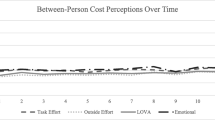Abstract
The influence of prior, irretrievable, investment (sunk cost) on commitment to a course of education was investigated. The moderating effects of the emotions of anger and fear over this commitment decision were also investigated. A total of 425 participants (214 male) with a mean age of 19.92 years were recruited from an undergraduate population. A computer program simulated the process of arranging to undertake a course of education. Participants were induced to feel either anger or fear and, then, invested one of three amounts of sunk cost (under budget, on budget, or over budget) to signing up for a course. Participants then decided how much time they wished to commit to this course or to an alternative, identical course with a better chance of success. Results revealed a significant sunk cost effect of prior investment on commitment to a course of education. Results also revealed that anger increased the magnitude of this sunk cost effect. Results did not reveal any effect of fear on the sunk cost effect. Theoretical implications and practical applications were discussed.

Similar content being viewed by others
References
American Psychological Association. (1992). Ethical principles of psychologists and code of conduct. American Psychologist, 47, 1597–1611.
Arkes, H. R. (1996). The psychology of waste. Journal of Behavioral Decision Making, 9, 213–224.
Arkes, H. R., & Blumer, C. (1985). The psychology of sunk cost. Organizational Behavior and Human Decision Processes, 35, 124–140.
Arkes, H. R., & Hutzel, L. (2000). The role of probability of success estimates in the sunk cost effect. Journal of Behavioral Decision Making, 13, 295–306.
Ǻstebro, T., Jeffrey, S. A., & Adomdza, G. K. (2007). Inventor perseverance after being told to quit: the role of cognitive biases. Journal of Behavioral Decision Making, 20, 253–272.
Bem, S. L. (1967). Self-perception: an alternative interpretation of cognitive dissonance phenomena. Psychological Review, 74, 183–200.
Boehne, D. M., & Paese, P. W. (2000). Deciding whether to complete or terminate an unfinished project: a strong test of the project completion hypothesis. Organizational Behavior and Human Decision Processes, 81, 178–194.
Coleman, M. D. (2009). Sunk cost and commitment to dates arranged online. Current Psychology, 28, 45–54.
Coleman, M. D. (2010). Sunk cost and commitment to medical treatment. Current Psychology, 29, 121–134.
Festinger, L. (1957). A Theory of cognitive dissonance. Stanford: Stanford University Press.
Finucane, M. L., Alhakami, A., Slovic, P., & Johnson, S. M. (2000). The affect heuristic in judgments of risks and benefits. Journal of Behavioral Decision Making, 13, 1–17.
Garland, H., Sandefur, C. A., & Rogers, A. C. (1990). De-escalation of commitment in oil exploration: when sunk costs and negative feedback coincide. Journal of Applied Psychology, 6, 721–727.
Girandola, F., & Gauthier, E. (2001). Organizational decision making: effects of accountability on escalation of commitment. European Review of Applied Psychology, 51, 111–119.
Heath, C. (1995). Escalation and de-escalation in response to sunk cost: the role of budgeting in mental accounting. Organizational Behavior and Human Decision Processes, 62, 38–54.
Juliusson, E. Á., Karlsson, N., & Gärling, T. (2005). Weighing the past and the future in decision making. European Journal of Cognitive Psychology, 17, 561–575.
Keltner, D., Ellsworth, P. C., & Edwards, K. (1993). Beyond simple pessimism: effects of sadness and anger on social perception. Journal of Personality and Social Psychology, 64, 740–752.
Keltner, D., Locke, K. D., & Audrain, P. C. (1993). The influence of attributions on the relevance of negative feelings to personal satisfaction. Personality and Social Psychology Bulletin, 19, 21–29.
Lerner, J. S., & Keltner, D. (2000). Beyond valence: toward a model of emotion-specific influences on judgment and choice. Cognition and Emotion, 14, 473–493.
Lerner, J. S., & Keltner, D. (2001). Fear, anger, and risk. Journal of Personality and Social Psychology, 81, 146–159.
Levenson, R. (1994). Human emotion: a functional view. In P. Ekman & R. J. Davidson (Eds.), The nature of emotion (pp. 123–126). New York: Oxford University Press.
Moon, H. (2001). Looking forward and looking back: integrating completion and sunk cost effects within an escalation of commitment progress decision. Journal of Applied Psychology, 86, 104–113.
Oatley, K., & Johnson-Laird, P. N. (1996). The communicative theory of emotions: Empirical tests, mental models, and implications for social interaction. In L. L. Martin & A. Tesser (Eds.), Striving and feeling: Interactions among goals, affect, and self-regulation. Hillsdale: Erlbaum.
Smith, C. A., & Ellsworth, P. C. (1985). Patterns of cognitive appraisal in emotion. Journal of Personality and Social Psychology, 48, 813–838.
Staw, B. M. (1976). Knee deep in the big muddy: a study of escalating commitment to a chosen course of action. Organizational Behavior and Human Performance, 16, 27–44.
Thaler, R. (1980). Towards a positive theory of consumer choice. Journal of Economic Behavior and Organization, 1, 39–60.
Tsai, M., & Young, M. J. (2010). Anger, fear, and escalation of commitment. Cognition and Emotion, 24, 962–973
US Bureau of Labor Statistics (2009). Consumer Expenditures in 2007. Retrieved June 5, 2010 from the World Wide Web. http://www.bls.gov/cex/csxann07.pdf
Zajonc, R. (1998). Emotions. In D. Gilbert, S. Fiske, & G. Lindzey (Eds.), The handbook of social psychology. New York: Oxford University Press.
Author information
Authors and Affiliations
Corresponding author
Rights and permissions
About this article
Cite this article
Coleman, M.D. Sunk Cost, Emotion, and Commitment to Education. Curr Psychol 29, 346–356 (2010). https://doi.org/10.1007/s12144-010-9094-6
Published:
Issue Date:
DOI: https://doi.org/10.1007/s12144-010-9094-6



